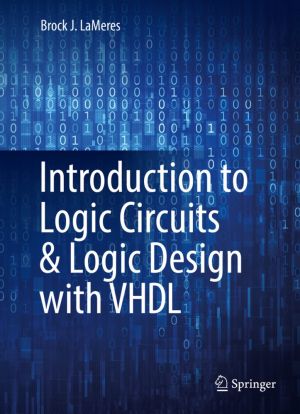Introduction to Digital Systems Design
by Giuliano Donzellini, Luca Oneto, Domenico Ponta, Davide Anguita
DescriptionDetailsHashtagsReport an issue 






Book Description
This book has been designed for a first course on digital design for engineering and computer science students. It offers an extensive introduction on fundamental theories, from Boolean algebra and binary arithmetic to sequential networks and finite state machines, together with the essential tools to design and simulate systems composed of a controller and a datapath. The numerous worked examples and solved exercises allow a better understanding and more effective learning. All of the examples and exercises can be run on the Deeds software, freely available online on a webpage developed and maintained by the authors. Thanks to the learning-by-doing approach and the plentiful examples, no prior knowledge in electronics of programming is required. Moreover, the book can be adapted to different level of education, with different targets and depth, be used for self-study, and even independently from the simulator. The book draws on the authors’ extensive experience in teaching and developing learning materials.This open book is licensed under a Creative Commons License (CC BY). You can download Introduction to Digital Systems Design ebook for free in PDF format (26.3 MB).
Book Details
Title
Introduction to Digital Systems Design
Subject
Engineering and Technology
Publisher
Springer
Published
2019
Pages
551
Edition
1
Language
English
ISBN13
9783319928036
ISBN10
3319928031
ISBN13 Digital
9783319928043
ISBN10 Digital
331992804X
PDF Size
26.3 MB
License

Related Books

This textbook introduces readers to the fundamental hardware used in modern computers. The only pre-requisite is algebra, so it can be taken by college freshman or sophomore students or even used in Advanced Placement courses in high school. This book presents both the classical approach to digital system design (i.e., pen and paper) in addition ...

This book for courses in Digital Systems Design introduces students to the fundamental hardware used in modern computers. Coverage includes both the classical approach to digital system design (i.e., pen and paper) in addition to the modern hardware description language (HDL) design approach (computer-based). Using this textbook enables readers to ...

This book for courses in Digital Systems Design introduces students to the fundamental hardware used in modern computers. Coverage includes both the classical approach to digital system design (i.e., pen and paper) in addition to the modern hardware description language (HDL) design approach (computer-based). Using this textbook enables readers to ...

A collection of readings and exercises aligned with the course, ME 270, Introduction to Mechanical Engineering Design, at Iowa State University. This course provides an overview of mechanical engineering design with applications to thermal and mechanical systems, and an introduction to current design practices used in industry. As part of the cours...

Introduction to Neuroscience is designed for undergraduate students enrolled in introductory neuroscience courses. This book specifically targets students enrolled in Introduction to Neuroscience 1 and Introduction to Neuroscience 2 at Michigan State University and primarily contains topics covered in those courses.
This first edition will guide...

An introduction to the engineering principles of embedded systems, with a focus on modeling, design, and analysis of cyber-physical systems.
The most visible use of computers and software is processing information for human consumption. The vast majority of computers in use, however, are much less visible. They run the engine, brakes, seatbelts,...

